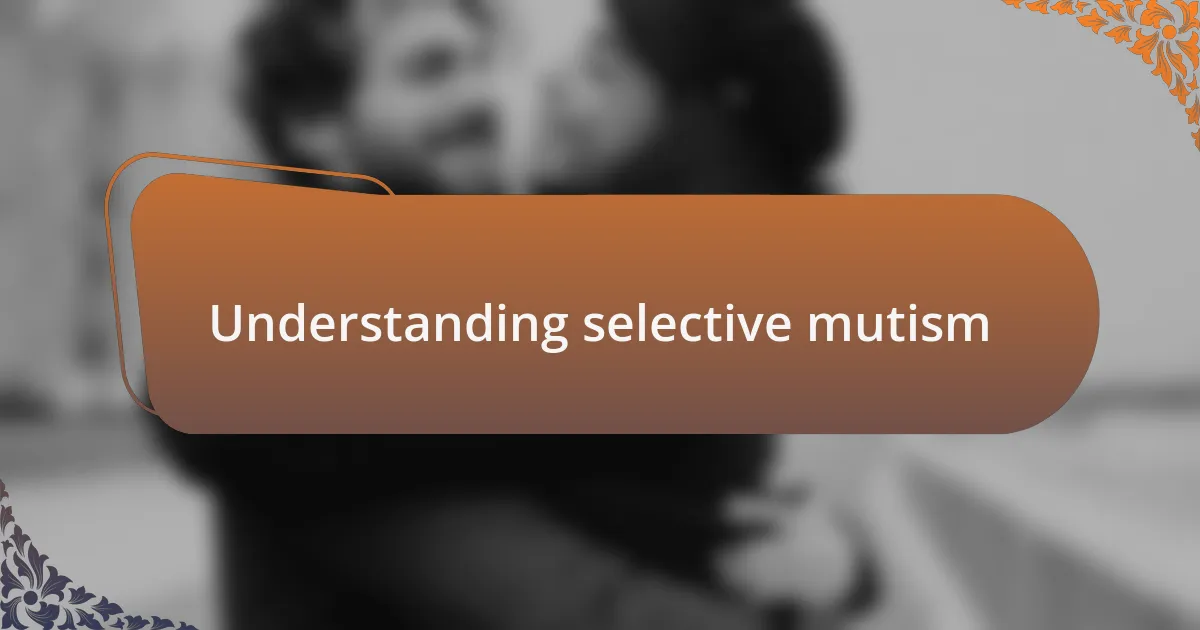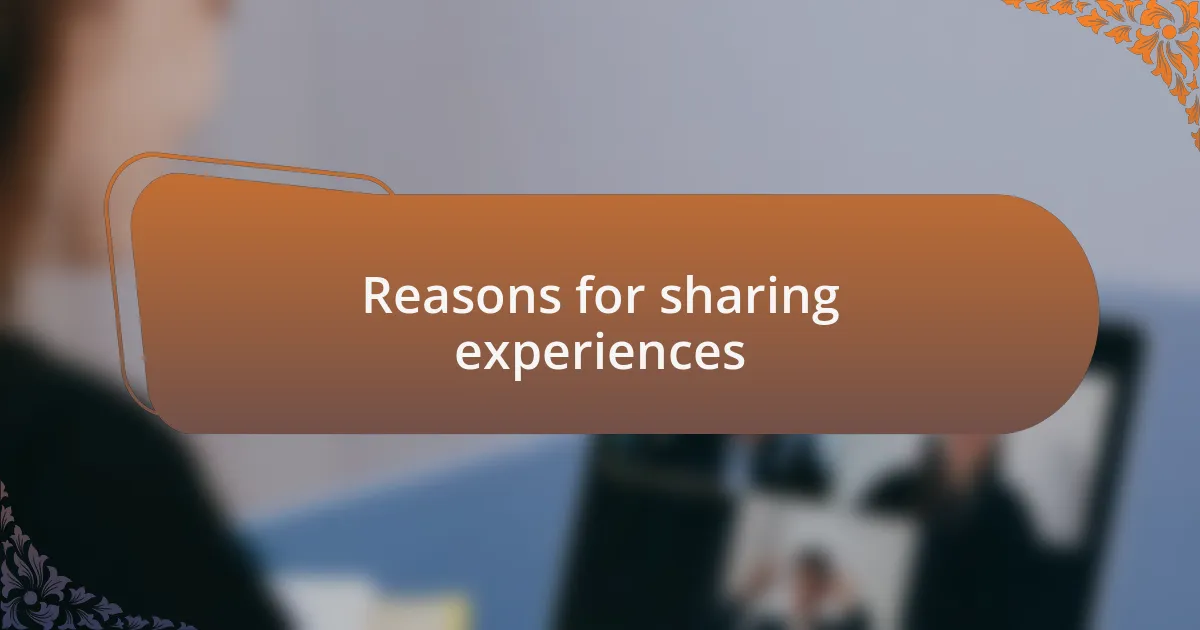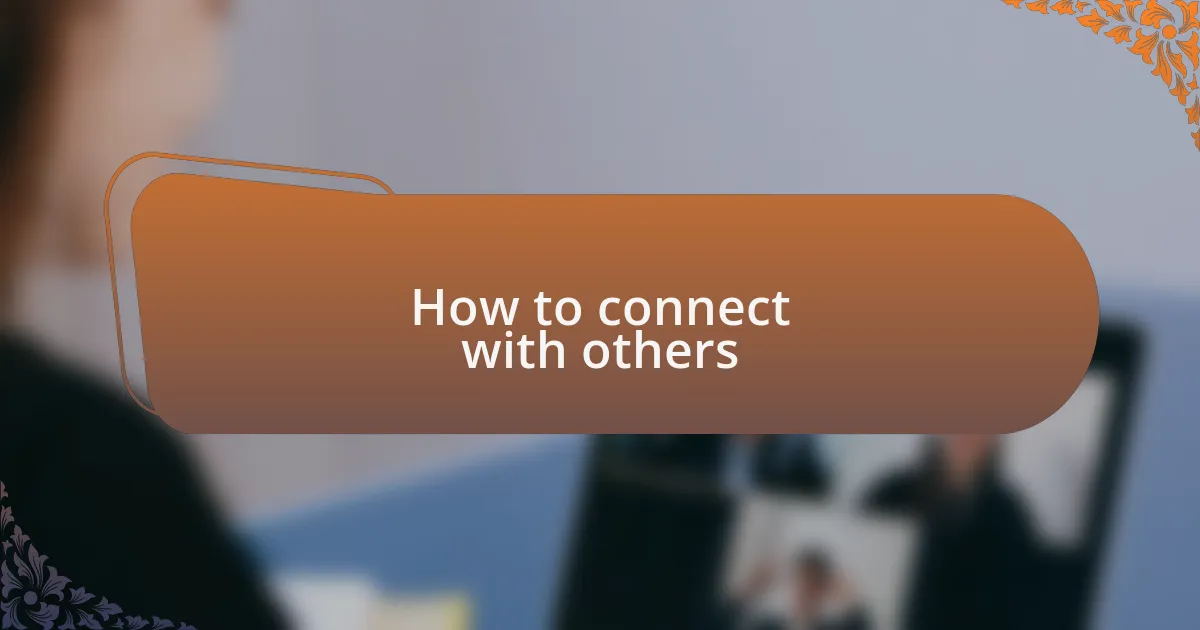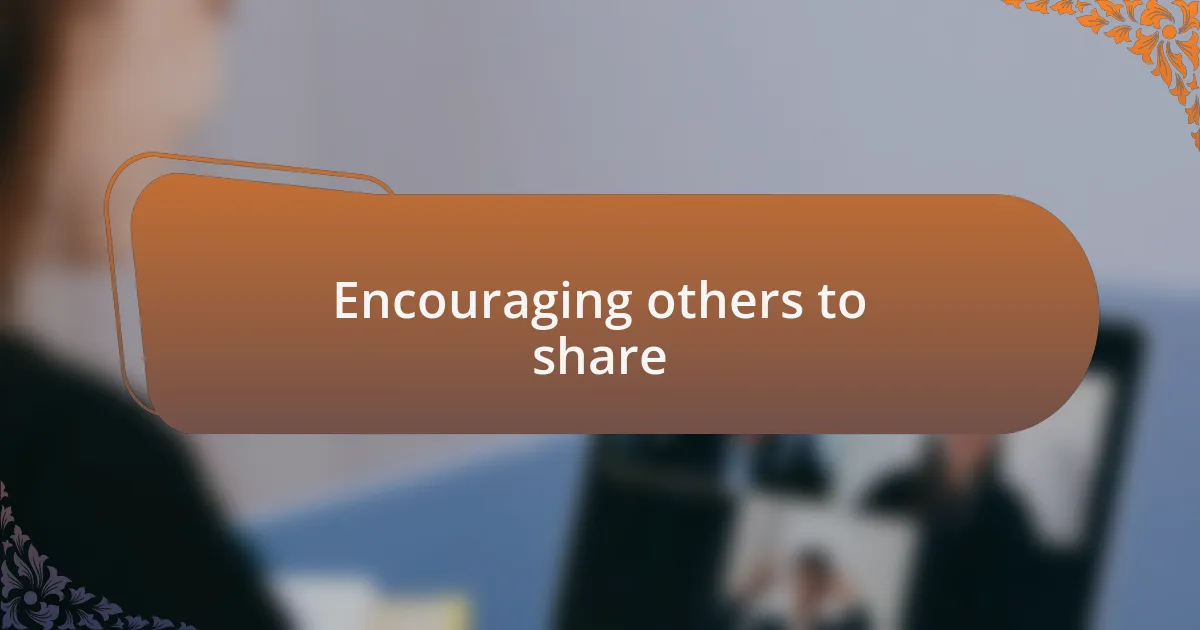Key takeaways:
- Selective mutism is a complex anxiety disorder, often mischaracterized as shyness, impacting a child’s ability to speak in social situations while they can communicate freely in comfortable settings.
- Raising awareness of selective mutism is essential for dispelling myths and providing support, as informed educators and communities can create inclusive environments for affected children.
- Sharing personal experiences fosters connection, provides hope, and educates others, helping to break stigma and encourage understanding about selective mutism.
- Effective communication strategies, such as using straightforward language and encouraging feedback, can enhance interactions, making it easier for individuals to express their experiences.

Understanding selective mutism
Selective mutism is a complex childhood anxiety disorder characterized by a child’s inability to speak in certain social situations, despite being able to communicate freely in comfortable environments. I remember once speaking to a mother whose daughter rarely spoke in school, yet at home, she would chatter endlessly, revealing the stark contrast that leaves many parents feeling confused and helpless. It made me wonder how often we overlook the emotional weight behind such silence.
Often mistaken for shyness, selective mutism is not just a personality trait; it’s a genuine struggle. I think about the children who might feel overwhelmed in a classroom, their hearts racing as they grapple with the fear of speaking up, even when they know the answers. How might their silence echo their internal turmoils, as they silently wish for understanding and support from those around them?
In understanding selective mutism, it’s essential to recognize the role of social anxiety and the profound impact it can have on a child’s development. I recall engaging with a young boy who found solace in drawing instead of talking; it was as if he communicated volumes through his art. Isn’t it fascinating how some children express themselves in unique ways, reminding us that communication isn’t solely about words?

Importance of raising awareness
Raising awareness about selective mutism is crucial, as it helps dispel the myths surrounding this disorder. When I first learned about it, I was struck by the realization that so many children suffer in silence, often misjudged as simply shy. This misunderstanding can lead to a lack of support, leaving both children and parents feeling isolated in their experiences.
The more we share stories and educate our communities, the more empathy we create. I recall attending a workshop where a therapist shared an experience of helping a little girl find her voice through gradual exposure. It made me think: how many children could benefit from just one person taking the time to understand their unique struggles? By raising awareness, we not only advocate for these children but also empower their families with the knowledge they need to seek appropriate support.
Awareness initiatives can lead to tangible changes in schools and social environments. I once spoke to a teacher who implemented simple strategies to help her selectively mute students feel safer in class. This opened my eyes to the idea that informed educators can create spaces where every child feels valued and understood. Isn’t it incredible to think about the positive ripple effects that awareness can foster in a child’s life?

Reasons for sharing experiences
Sharing experiences can be a powerful tool for connection. I remember the first time I opened up about my own struggles with selective mutism during a support group. The relief in the room was palpable; others nodded along in understanding, and I realized how vital it is to demonstrate that we aren’t alone in our journeys. Isn’t it comforting to know that there are others who feel the same fears and frustrations?
One significant reason for sharing our stories is to provide hope and inspiration to those who may feel trapped in silence. I once heard from a young adult who shared their journey on a blog, detailing how they gradually found their voice over several years. Their honesty and vulnerability sparked something in me; it made the seemingly impossible feel achievable. Doesn’t it make a difference when someone shares how they overcame obstacles, showing us that progress is possible?
Educating others through our experiences can lead to greater understanding and empathy in society. I’ve personally had conversations with friends who, after hearing my story, changed the way they approach children who exhibit signs of selective mutism. It’s amazing how a simple conversation can shift someone’s perspective. Isn’t it worth sharing our experiences if it means creating a more supportive environment for those who need it most?

Benefits of personal storytelling
The power of personal storytelling lies in its ability to foster genuine connections. I remember attending a community event where a someone shared their journey with selective mutism. As they spoke, I could feel the room shift—eyes widened, hearts opened. It was obvious people were relating to the raw emotions expressed, creating a bond that words alone could not establish. Have you ever felt that moment when someone’s story resonates with your own?
Additionally, I find that sharing personal narratives can be a form of self-therapy. When I write about my experiences, I often discover insights about my own feelings and reactions. It’s almost like peeling back the layers of an onion—each layer revealing something deeper and more profound. This process not only helps me understand myself better but also allows me to articulate the complexities surrounding selective mutism more clearly. Isn’t it interesting how our own vulnerabilities can lead to greater self-awareness?
Furthermore, personal stories actively contribute to breaking down stigma. During a recent workshop on mental health, I shared a specific incident that highlighted the misconceptions around selective mutism. The shocked faces in the audience were a testament to how little understanding exists about this condition. I could sense an eagerness to learn and engage in thoughtful discussions afterward. Isn’t it incredible how one story can spark curiosity and encourage a shift in dialogue? Each narrative shared can be an opportunity to educate and empower not only ourselves but those around us.

How to connect with others
When it comes to connecting with others, I’ve learned that vulnerability can be a bridge rather than a barrier. I recall a time when I hesitated to share my struggles with selective mutism during a small group discussion. Once I took that leap, I was surprised to find others nodding along, revealing their own stories of similar challenges. It made me realize how powerful it is to create a safe space by simply being honest about my experiences.
Listening is just as essential as sharing when trying to connect. I once participated in a support group where everyone had a chance to speak, but it was the moments of silence between stories that truly resonated with me. Those pauses encouraged deeper reflection and let me know I was heard. Have you ever noticed how silence can sometimes speak louder than words? It invites intimacy and understanding, allowing relationships to flourish.
Finding common ground can significantly enhance our connections. I remember engaging in an online forum dedicated to selective mutism, where every contributor brought their unique perspective. Sharing articles, experiences, and even silly memes broke down barriers and sparked laughter. Isn’t it amazing how a shared interest, even if it touches on such personal struggles, can create a sense of community? Establishing these connections makes the journey feel far less lonely.

Strategies for effective communication
Effective communication requires clarity and patience, especially when addressing sensitive topics like selective mutism. I often find that using concise and straightforward language helps convey my thoughts without overwhelming others. Have you ever noticed how a simple “let me share my experience” can open doors to meaningful conversations? Keeping it direct can encourage an open exchange.
Building rapport through non-verbal cues can transform interactions. I remember attending a workshop where participants practiced making eye contact, nodding, and using open body language. These subtle gestures made a significant difference. They not only made me feel more at ease but also seemed to encourage others to engage more authentically. It’s fascinating how a smile or a nod can bridge gaps and foster connection.
Encouraging feedback can enhance the communication process immensely. I’ve learned to ask open-ended questions, like “What do you think about this?” after sharing my thoughts. This technique not only invites others into the dialogue but also shows that I value their input. Have you ever experimented with this approach? The responses I receive often enrich the conversation and make it more meaningful, turning dialogue into a collaborative experience.

Encouraging others to share
Encouraging others to share their experiences can begin with simple, inviting gestures. I recall a moment when I organized a small group discussion on selective mutism. I placed chairs in a circle and softly encouraged everyone to talk, reminding them that their experiences were valid and important. Have you ever felt a wave of relief when someone else shared a similar struggle? That shared vulnerability opened the floodgates for others to express themselves too.
Asking thought-provoking questions is another powerful way to foster sharing. I once posed the question, “What was your most challenging moment, and how did you cope with it?” The room fell silent for a moment, but then one brave individual stepped up, and their story sparked a chain reaction. It’s incredible how a single question can create such a supportive atmosphere, allowing voices that often go unheard to resonate loudly.
Another tactic I’ve found effective is sharing my own uncertainty. When I admit that I sometimes struggle to articulate my feelings, I notice others nodding in agreement. It’s as if my honesty gives them permission to be vulnerable too. Why do you think that is? Perhaps it’s because authenticity draws out authenticity, creating a safe space for everyone involved.